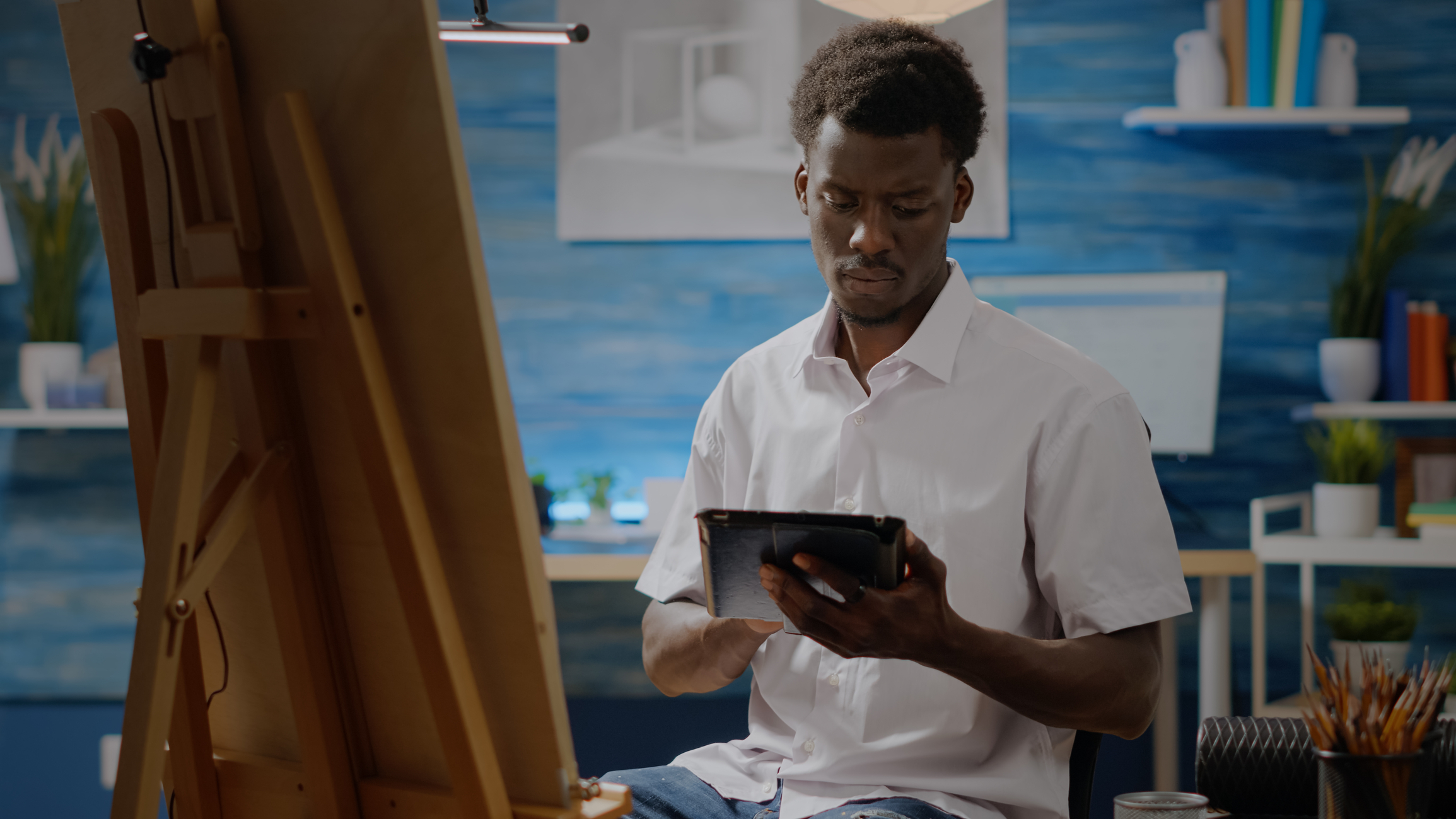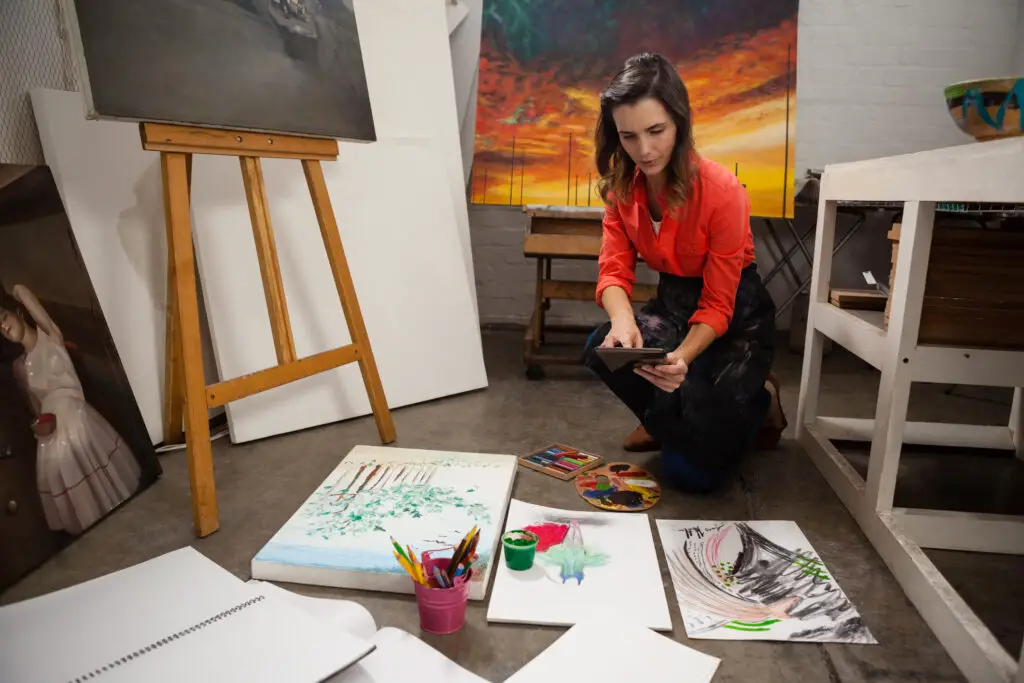Artificial intelligence (AI) is blurring the definition of creativity and what it means to be an artist. In recent years, the term “AI art” has become a trending topic in the art world, but what is AI art, exactly? Is it solely the product of a computer program, or is it an artist’s work?
AI art uses machine learning algorithms to enable computers to “learn” successful artistic aesthetics by analyzing thousands of images. Then, without human guidance or input, artificial intelligence makes creative choices to generate novel artwork autonomously.
So, what do you think? Will AI artwork replace artists or help them create even more unique pieces? We’ll cover the basics of the history of AI artwork, how it’s made, and its current impact below.

Short History of AI Artwork
In the past few years, deep learning AI neural networks have done an excellent job in artistic image analysis and creating images that some people call “art.”
All these didn’t spring forth from just anything in the 21st century. There are a lot of early seeds that have made the field what it is today. But we won’t go that far back. We’ll start with the first art programs and proceed to the sale of the first AI-generated portrait sold at auction.
1973 - Harold and AARON
Harold Cohen was a painter and art teacher interested in computers in the 1960s. Cohen’s fundamental question was, “What makes an image evocative?” Can algorithms produce evocative images not rarely and accidentally but consistently?
In 1971, he taught himself to program and, in 1973, created AARON - a program that produces drawings autonomously that he would develop into paintings.

An Early Drawing by AARON, 1974. Colored in pencil by Harold Cohen
Cohen’s AARON was one of the first examples of generative art, or art created by a system that follows algorithms or specific rules rather than being wholly created directly by an artist.
2001 - The Painting Fool
Computational creativity is a field of research focused on developing software that can be creative independently, either as a collaborator with people or as an autonomous artist, musician, writer, designer, engineer, or scientist.
At the Computational Creativity Group at Imperial College in London, Simon Colton created the Painting Fool. The painting fool was a big inspiration for many AI systems that would come after.

The Painting Fool is a computer program that can paint autonomously. It achieves this by mimicking the creative behaviors of a human painter - making marks on a canvas, painting scenes in different styles, choosing styles in a meaningful way, painting new scenes from imagination, inventing scenes for a purpose, and learning and progressing as an artist.
2009 - ImageNet
In 2009, a group of computer scientists at Stanford University released ImageNet. It was a database of more than 14 million images labeled with keywords by humans.
The more data an algorithm has, the better it can learn. More is better because it can reflect the real world more accurately. The release of ImageNet was a turning point in the development of AI because it allowed computer vision algorithms to be trained on such a large dataset for the first time.
ImageNet is known as the dataset that transformed AI research. It made computers “see” the world for the first time on a grand scale.
2014 - Generative Adversarial Networks
To avoid confusion, I’ll first explain a neural network. A neural network is a machine learning algorithm or a set of rules instructing a computer on how to analyze data and learn from it.
A generative adversarial network, also known as a GAN, is a type of neural network that trains a computer to generate synthetic data.
GANs work by pitting two neural networks against each other in a “game” to improve their performance. One network is called the “generator,” and the other is called the “discriminator.”
The generator creates data samples, while the other, the discriminator, tries to distinguish between data generated by the generator and data from a real dataset. The two networks constantly compete against each other, with the generator trying to produce data that is indistinguishable from data from the actual dataset and the discriminator trying to identify which data samples are fake.
This process results in a feedback loop that allows the generator to improve its ability to create realistic data samples.
Since its introduction in 2014, GAN has been a fantastic framework that trains computers to generate realistic images from scratch.
2015 - Neural Style Transfer
Neural Style Transfer is a technique in deep learning that allows you to take two images—a content image and a style image—and combine them to create a new third image that contains the content of the first image and the style of the second.
For example, if you took a picture of a cat and combined it with the style of Vincent van Gogh’s Starry Night, you would get a new image that contains the cat but is painted in the style of Van Gogh.


This technique gained momentum in 2015 and has been used to create some incredible AI-generated artwork.
2018 - Sale of “Edmond de Belamy”
An AI-generated painting of a blurred face called “Edmond de Belamy” was sold at Christie’s auction house in 2018 for $432,500.
This painting was created by an AI algorithm that was taught the aesthetics of portraiture by going through thousands of portraits.

Edmond de Belamy
How Do Machines Create AI Artwork?
It won’t hurt to poke around a little more to understand how AI-created art is made before we go further and see why it’s becoming trendy.
So, how do machines create AI artwork?
To answer this, I will talk about Ahmed Elgammal. He is a director at the Art and Artificial Intelligence Laboratory at Rutgers University. Ahmed and his team created AICAN (artificial intelligence creative adversarial network).
“[AICAN] is a program that could be thought of as a nearly autonomous artist that has learned existing styles and aesthetics and can generate innovative images of its own.”
Ahmed Elgammal said in the American Society journal that for AICAN to create images, such as the one it made that sold for $16,000 at a particular auction, AICAN first goes through a sort of “history” lesson, much like an artist taking a history course.
Here, the machine is fed with, for example, 80,000 images that represent the Western art canon over the previous five centuries.
After AICAN has taken its history lesson, it can start making art of its own by combining the knowledge it has gleaned from all the images it has seen and deviating a little more from the styles of those images.
This deviation is what creates the novelty in the generated art.
So basically, a machine creates artwork by looking at images, analyzing them, and then creating something new that is similar to what it has seen but with a touch of novelty. The learning, examining, and creating process is all done by AI algorithms.
Why Has AI Art Become Trendy?
AI art is becoming trendy for a few reasons:
- It’s a new, fascinating form of art
- AI art is seen as a way to democratize the art world.
- AI tools are getting better and cheaper by the day.
The first reason is pretty apparent. AI art is a new, fascinating way to create art. It’s like nothing we’ve seen before, and people are naturally curious about it.
The second reason has to do with the fact that AI art is seen as a way to democratize the art world. AI systems make it easy for people from all backgrounds to create artworks that are on par with those produced by professional artists.
The third reason is that the generation of realistic or hyperrealistic data using AI systems is getting better and cheaper by the day; hence, more people can afford to create AI art.
Additionally, improvements in Natural language Processing (NLP) algorithms make new AI tools possible.
Natural language processing is a branch of artificial intelligence that deals with teaching computers to understand human language.
When you use a text-to-image AI art generator, you type a brief text describing what you want to see in the generated image. NLP helps the computer interpret your words and, therefore, better create original images that reflect the themes of the input text.

Will AI Artwork Replace or Help Artists?
Let’s start with the recent news of an AI-generated artwork that won a competition. Some artists weren’t too pleased about it. Perhaps they feel that AI artwork will replace artists. I argue that AI technologies are invaluable tools for artists.
Here’s why:
Artists have always initially given pushback to the introduction of technology tools to help create their art. Believe it or not, when cameras were introduced, artists were worried that photography would be the end of painting. But, of course, that didn’t happen.
It’s not novel for new technologies to cause fears of displacement among traditional artists. But these new tools ultimately enable new artistic styles and keep art forms from getting stale. AI technologies follow this trend.
AI artwork isn’t going to put artists out of jobs. It’s quite the opposite; AI technologies provide new tools and modes of expression that help artists create new styles of expression. These new tools also make art more accessible to broader sections of society, both as creators and as consumers.
One last point to drive home is that computers do not create art; people use computers to create art. The work we call “Computer-generated art” results from human invention, software development, tweaking, and other kinds of direct control and authorship.
We credit the human artist as the author, acknowledging that the human is always the mastermind behind the work and that a computer is a tool. And, of course, an AI system is a more sophisticated tool than our dear friend, the camera.
Do you know who owns the copyrights to AI artwork? Check out my comparison article.
So don’t worry, artists! AI artwork is not going to replace you. It’s just another tool that you can use to create art. And who knows, maybe one day, your AI artwork will be the one winning a competition.😉